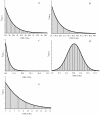Phylogenetic status and timescale for the diversification of Steno and Sotalia dolphins
- PMID: 22163290
- PMCID: PMC3233566
- DOI: 10.1371/journal.pone.0028297
Phylogenetic status and timescale for the diversification of Steno and Sotalia dolphins
Erratum in
- PLoS One. 2012;7(8): doi/10.1371/annotation/e624380d-1b9c-4134-a68d-83629fbf26e1
Abstract
Molecular data have provided many insights into cetacean evolution but some unsettled issues still remain. We estimated the topology and timing of cetacean evolutionary relationships using bayesian and maximum likelihood analyses of complete mitochondrial genomes. In order to clarify the phylogenetic placement of Sotalia and Steno within the Delphinidae, we sequenced three new delphinid mitogenomes. Our analyses support three delphinid clades: one joining Steno and Sotalia (supporting the revised subfamily Stenoninae); another placing Sousa within the Delphininae; and a third, the Globicephalinae, which includes Globicephala, Feresa, Pseudorca, Peponocephala and Grampus. We also conclude that Orcinus does not belong in the Globicephalinae, but Orcaella may be part of that subfamily. Divergence dates were estimated using the relaxed molecular clock calibrated with fossil data. We hypothesise that the timing of separation of the marine and Amazonian Sotalia species (2.3 Ma) coincided with the establishment of the modern Amazon River basin.
Conflict of interest statement
Figures



References
-
- Graur D, Higgins DG. Molecular Evidence for the Inclusion of Cetaceans within the Order Artiodactyla. Molecular Biology and Evolution. 1994;11:357–364. - PubMed
-
- Gatesy J, Hayashi C, Cronin MA, Arctander P. Evidence from milk casein genes that cetaceans are close relatives of hippopotamid artiodactyls. Molecular Biology and Evolution. 1996;13:954–963. - PubMed
-
- Nikaido M, Rooney AP, Okada N. Phylogenetic relationships among cetartiodactyls based on insertions of short and long interpersed elements: Hippopotamuses are the closest extant relatives of whales. Proceedings of the National Academy of Sciences of the United States of America. 1999;96:10261–10266. - PMC - PubMed
-
- Gatesy J, O'Leary MA. Deciphering whale origins with molecules and fossils. Trends in Ecology & Evolution. 2001;16:562–570.
-
- Agnarsson I, May-Collado LJ. The phylogeny of Cetartiodactyla: The importance of dense taxon sampling, missing data, and the remarkable promise of cytochrome b to provide reliable species-level phylogenies. Molecular Phylogenetics and Evolution. 2008;48:964–985. - PubMed
Publication types
MeSH terms
Substances
LinkOut - more resources
Full Text Sources

